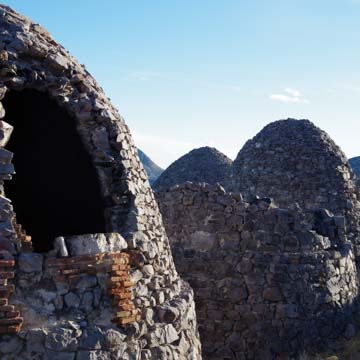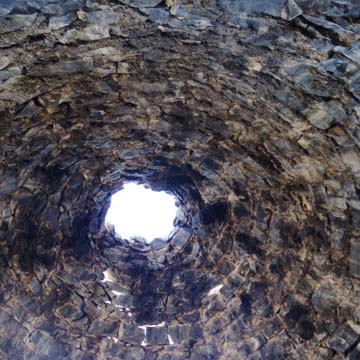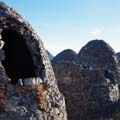The Frisco Charcoal Kilns were among the earliest built in Utah. Located in Beaver and named for the San Francisco Mountains in which they are situated, the kilns were erected by the Frisco Mining and Smelting Company in 1877 to burn wood into charcoal for the smelting process. They were a critical part of the infrastructure that made silver mining in this area possible.
The five kilns are arranged in a semi-circle, with a berm approximately two to four feet behind them that forms an enclosure. The kilns are built of local rough granite and lime mortar, and their beehive shape controlled the draft that would otherwise result in uneven conversion of wood into charcoal. Three of the kilns are blunted at the top, while two rise to a point. An inward-sliding arched opening for feeding wood at the bottom is complemented on the other side by an outwardly protruding opening two-thirds of the distance to the apex. Each kiln possesses three rows of air vents, with each vent measuring approximately 3 x 4 inches and each row spaced 1.5 feet apart from one another. Vents were covered with wood logs, whose remnants can be still seen. While kiln size in general varied from 16 to 26 feet in diameter, at Frisco they are larger, between 21 and 23.5 feet in diameter and a height of 22 feet. The walls at the base of kilns measure 2 feet thick and they narrow to one inch at the apex. One of the kilns exhibits three sections where an apparent patchwork of soft red firebrick was added at an unknown date. A trace of white stucco found on some of the kilns indicates this material was probably used to cover the exterior surface.
By the 1880s, silver mining ceased in the area, with the Horn Silver Mining Company departing Frisco in 1882, and the Frisco Mining and Smelting Company closing two years later. The kilns were abandoned and the property has since changed hands several times; it is now owned by Tintic Minerals Resources, Inc. and Horn Silver Mining Company. These rugged structures remain the best surviving charcoal kilns in the state.
References










